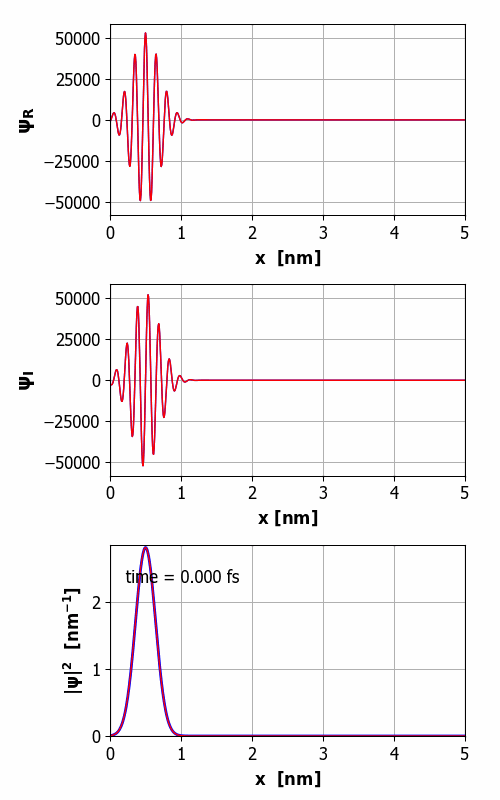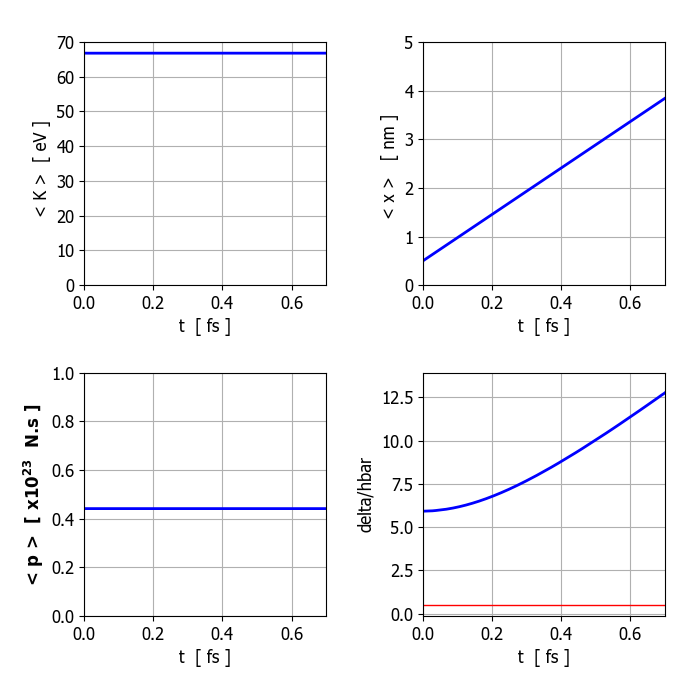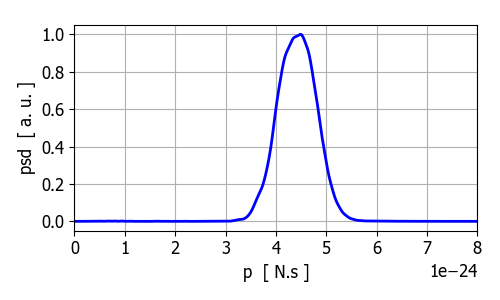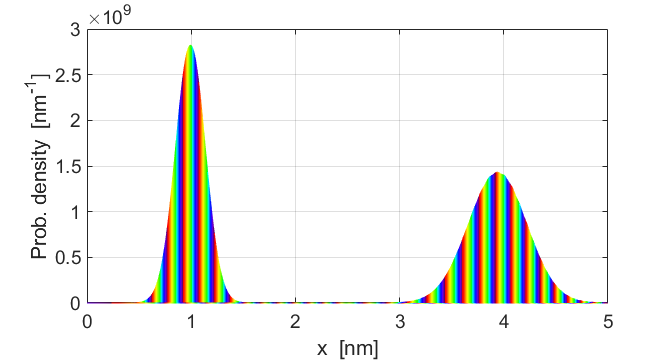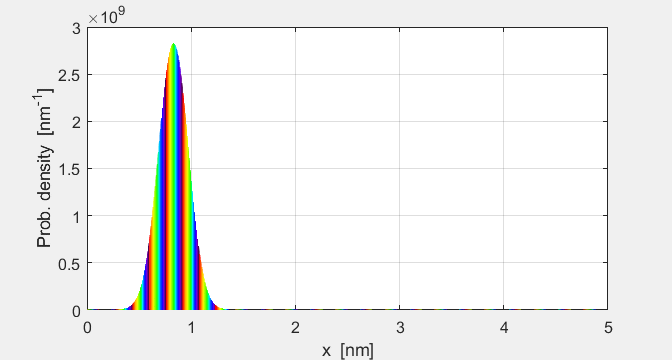QUANTUM MECHANICS
TIME DEPENDENT SCHRODINGER EQUATION FINITE DIFFERENCE TIME DEVELOPMENT METHOD FREE PARTICLE: GAUSSIAN WAVEPACKET PROPAGATION Ian
Cooper matlabvisualphysics@gmail.com DOWNLOAD DIRECTORY FOR MATLAB SCRIPTS qm005.py GAUSSIAN PULSE
PROPAGATION As an example of solving the [1D] time
dependent Schrodinger equation for a free particle (unbound particle),
let’s consider an electron confined
to the X axis in the region from where A is a
normalized constant and is calculated so that This
unbound state is in a classically allowed region and so the energies of the
system are not quantized and the total energy E can
vary continuously. In the
Python code qm005.py, the initial state (t = 0) of
the wavepacket is expressed in terms of its real
(yR) and imaginary (yI) parts:
The particle represented
by a wavepacket is localized in space with an approximately well-defined
momentum
When the wave
packet strikes a boundary at x = 0 or x = L, reflections occur. This may cause
problems, so it may be necessary to terminate a simulation before any
reflections occur. The accuracy of the FDTD
method is improved as SIMULATIONS Simulation
parameters for Script qm005.py Nx
= 701
number of grid points for x-axis Nt =
4200
number of time steps L = 5x10-9
m
simulation region xC = 5x10-10
m
centre of pulse
nx1 = round(Nx/10) S =
L/25
width of pulse
C1 = 1/5 f
=100
number of animation frames An
animation of the time evolution of the Gaussian wavepacket is shown in figure
1.
Fig.
1. Animation of the
Gaussian wavepacket from its initial state. The top graph shows the real
part of the wavefunction, the middle graph the imaginary part, and the
bottom graph, the probability density.
Fig.
2. Time evolution plots.
The uncertainties in the position You will notice that the width of the
wavepacket grows with time, i.e., wavepacket
spreading.
Although,
the wavefunction develops real and imaginary parts, both of which have lots
of wiggles, the probability density turns out to be another Gaussian function
with a width that increases with time. Eventually, the width of the
wavepacket is proportional to time (figure 2). The
initial wavefunction has a spread of momentum and this distribution of
momentum remains constant for a free particle because there are zero forces
to change it. Since there is a spread in possible momenta, there is also a
spread in velocities The wavepacket
as it spreads propagates in the +X direction. Since there are zero forces
acting on the system, the momentum of the wavepacket is constant, as a
result, the expectation values of momentum, total energy, kinetic energy and
potential energy are constants, independent of time. In the time evolution of the wave packet the
Heisenberg Uncertainty Principle is satisfied. You can decrease the width of the
wavepacket and run a simulation. You will notice that decreasing the spatial
width of the initial wave packet increases the spread of momenta and
therefore increases the rate at which the wavepacket spreads. We can
calculate the classical values of velocity, momentum and kinetic energy:
where Classical
values v = 4.78e+06 m/s p = 4.35e-24 N.s K = 64.84 eV We can
calculate the expectation values of velocity, momentum and kinetic energy:
Expectation
values v = 4.85e+15 m/s p = 4.42e-24 N.s K = 66.81 eV There is
excellent agreement between the classical predictions and the expectation
values. For the
wave nature of the wavepacket, the momentum and energy are given by the
equations Group and
Phase velocities wL _0 =
1.50e-10 m p_0 = 4.35e-24 N.s f_0 =
1.62e+16 Hz vGroup = 4.78e+06 m/s vPhase = 2.42e+06 m/s vGroup
/ vPhase = 1.97 We can
perform a Fourier transform on the wavepacket function to compute the power
spectrum density (psd) in momentum space Figure 3
shows the psd in momentum space for
Fig.
3. Power spectral density
functions in momentum space. The Fourier transform of a Gaussian function is
a Gaussian function. The
wavepacket is a mixture of waves moving at a whole range of velocities
(momenta), so as it moves along, some of these components move faster than
others. Soon this dispersion causes
the wavepacket to spread out (just as a large group of hikers naturally
spreads out along the trail, with the faster ones in the lead and the slower
ones behind). Although the wavelength of the oscillations within the packet
is initially uniform, it will not remain uniform. The wavepacket moves and
spreads, its leading edge will contain shorter-wavelength (higher-velocity)
oscillations, while its trailing edge will contain longer-wavelength
(lower-velocity) oscillations. Meanwhile the peak amplitude of the wavepacket
will decrease, to conserve probability as the width increases as illustrates
in the animation of figure 1. All that can happen to a classical particle is
that it can move from one position to another. But, a quantum mechanical
wavepacket undergoes a more complicated evolution with time in which the
whole probability distribution shifts and spreads with time. The Ehrenfest’s theorem is a general statement about the rates of change
of Ehrenfest’s theorm If a particle of mass m is in a state described by a normalized
wavefunction in a system with a potential energy function In this simulation, you can see that
Ehrenfest’s theorem is satisfied. The momentum and its uncertainty
remain constant. The distance d that the peak of the probability distribution
moves in the time interval
You can also visualize
the complex phase of the wavepacket,
where a colour is used to represent the phase between the real and imaginary
components. Figure 4 shows the complex phase of the Gaussian wavepacket at
the start and end of the simulation period. Figure 5 shows an animation of
the changing complex phase changes as the wavepacket propagates.
Fig.
4. The complex phase of the
Gaussian wavepacket at the start and end of the simulation period.
Fig.
5. Animation of the complex
phase as the Gaussian wavepacket propagates. NOTE: Figures
4 and 5 are produced in Matlab. I have not worked out how to make the
animations in Python as yet. |



